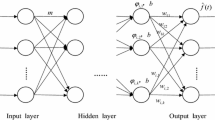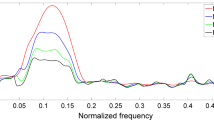Abstract
Due to the demand of data processing for polar ice radar in our laboratory, a Curvelet Thresholding Neural Network (TNN) noise reduction method is proposed, and a new threshold function with infinite-order continuous derivative is constructed. The method is based on TNN model. In the learning process of TNN, the gradient descent method is adopted to solve the adaptive optimal thresholds of different scales and directions in Curvelet domain, and to achieve an optimal mean square error performance. In this paper, the specific implementation steps are presented, and the superiority of this method is verified by simulation. Finally, the proposed method is used to process the ice radar data obtained during the 28th Chinese National Antarctic Research Expedition in the region of Zhongshan Station, Antarctica. Experimental results show that the proposed method can reduce the noise effectively, while preserving the edge of the ice layers.
Similar content being viewed by others
References
L. A. Plewes and B Hubbard. A review of the use of radio-echo sounding in glaciology. Progress in Physical Geography, 25(2001)2, 203–236.
Cui Xiang-Bin, Sun Bo, Tian Gang, et al.. Ice radar investigation at Dome A, East Antarctica: Ice thickness and subglacial topography. Chinese Science Bulletin, 55(2010)4–5, 425–431.
S. Gogineni, T. Chuah, C. Allen, et al.. An improved coherent radar depth sounder. Journal of Glaciology, 44(1998), 659–669.
Scientific Committee on Antarctic Research (SCAR). The Role of the Antarctic in Global Change, an International Plan for A Regional Research Program. Cambridge: University Printing Services, 1993, 11–54.
D. Carevic. Wavelet-based method for detection of shallowly buried objects from gpr data. IEEE Proceedings of Information, Decision and Control, Adelaide, Australia, 1999, 201–206.
M. Aleix Martinez and C. Avinash Kak. PCA versus LDA. IEEE Transactions on Pattern Analysis and Machine Intelligence, 23(2001)3, 228–233.
Dai Shun. Research and Implementation of Vital Jiggle Signal Detection for UWB Radar. [Doctorate Dissertation], Graduate University of the Chinese Academy of Sciences, 2011 (in Chinese). 戴舜. s超宽带雷达生命微动信号探测方法技术实现. [博士学位论文], 中国科学院研究生院, 2011 年.
E. Candes and D. Donoho. New tight frames of Curvelets and optimal representations of objects with C2 singularities. Communications on Pure and Applied Mathematics, 57(2004)2, 219–266.
D. Donoho, M. Duncan. Digital curvelet transform: strategy, implementation and experiments. Proceedings of Aerosense 2000, Wavelet Application VII, SPIE, 4065(2000)3, 12–29.
Xiao-Ping Zhang. Thresholding neural network for adaptive noise reduction. IEEE Transactions on Neural Networks, 12(2001)3, 567–583.
E. Candes, L. Demanet, D. Donoho, and L. Ying. Fast discrete curvelet transforms. Multiscale Modeling & Simulation, 5(2006), 861–899.
J. Starck, E. Candes and D. Donoho. The Curvelet transform for image denoising. IEEE Transactions on Image Processing, 11(2002)6, 670–684.
D. Dohoho. De-noising by soft-thresholding. IEEE Transactions on Information Theory, 41(1995)3, 613–627.
Cen Yi-gang, Wei Yu, and Sun De-bao. The application of wavelet threshold neural network in the de-noising and prediction. Control Theory & Applications, 25(2008)3, 12–29.
Charles M. Stein. Estimation of the mean of a multivariate normal distribution. The Annals of Statistics, 9(1981)6, 1135–1151.
E. Candes, L. Demanet, D. Donoho, and Lexing Ying. CurveLab toolbox. http://www.curvelet.org, 2012.
Qin Da-he and Ren Jia-wen. Antarctic Glaciology. Beijing, Science Press, 2001, 2–10.
P. Kanagaratnam, S. Gogineni, N. Gundestrup, et al.. High-resolution radar mapping of internal layers at the North Greenland Ice Core Project. Journal of Geophysical Research, 106(2001)D24, 799–811.
Cui Xiang-bin, Sun Bo, Zhang Xiang-pei, et al.. A review of ice radar’s technical development in polar ice sheet investigation. Chinese Journal of Polar Research, 21(2009)4, 322–335.
Author information
Authors and Affiliations
Corresponding author
Additional information
Supported by the National High Technology Research and Development Program of China (No. 2011AA040202) and the National Natural Science Foundation of China (No. 40976114).
Wang Wenpeng, born in 1983, male, Doctor Degree.
About this article
Cite this article
Wang, W., Zhao, B. & Liu, X. Application of noise reduction method based on Curvelet Thresholding Neural Network for polar ice radar data processing. J. Electron.(China) 30, 377–383 (2013). https://doi.org/10.1007/s11767-013-3056-8
Received:
Revised:
Published:
Issue Date:
DOI: https://doi.org/10.1007/s11767-013-3056-8




